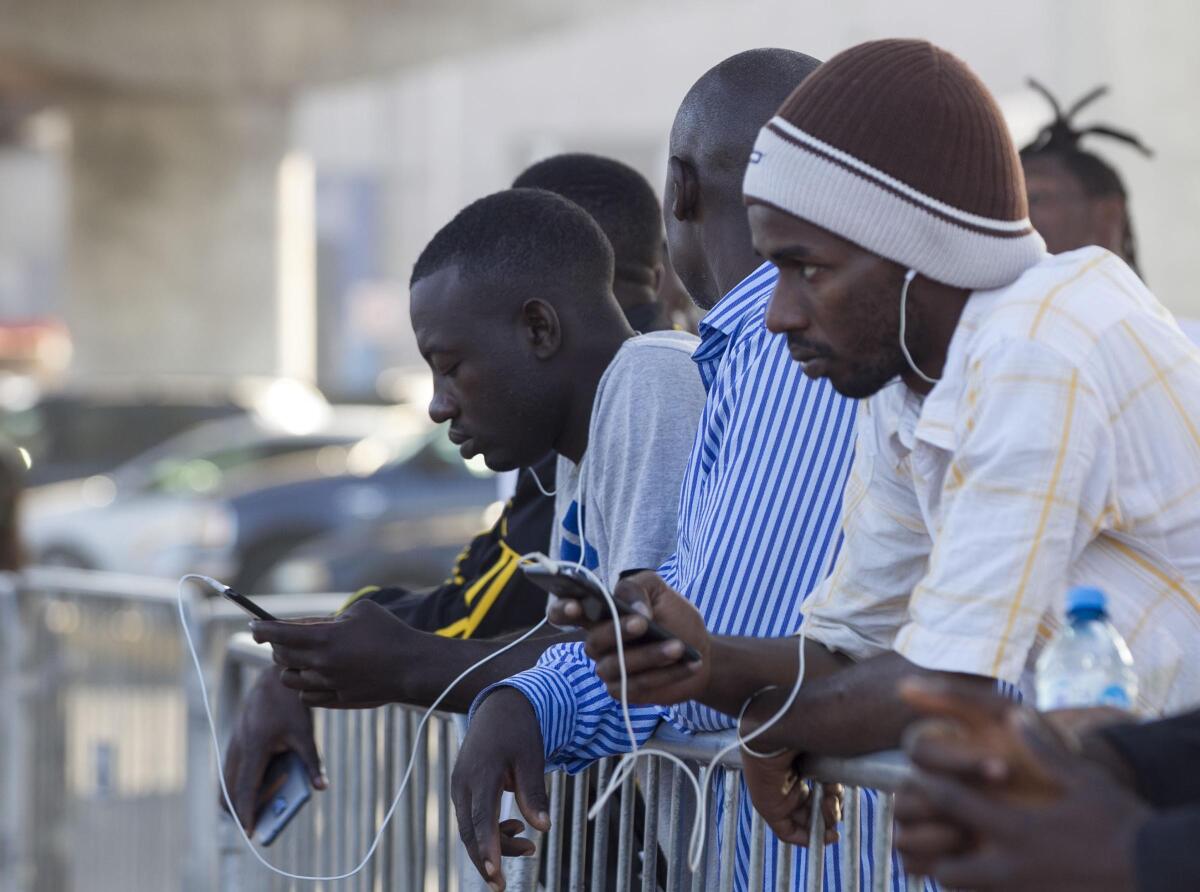Record number of African migrants at U.S.-Mexico border

The number of migrants from African countries in Mexico who have had contact with Mexican immigration officials has increased from 460 in 2007 to more than 5,800 in 2019
- Share via
The number of African migrants heading to the U.S. through Mexico has more than doubled this year — from roughly 2,700 in 2018 to 5,800 today, according to data from the federal government.
That figure has been steadily rising since 2007 — the year the Mexican government began including migrants from African countries who have contact with immigration officials in their annual migration reports — when the number was 460.
And that dramatic increase has been mostly left out of U.S. immigration conversations, activists say.
“Even within the immigration movement, you see a lack of visibility of black narratives with what is happening at the border,” said Guerline Jozef, director and co-founder of the Haitian Bridge Alliance, an organization that helps black migrants from all over the world.
Jozef was initially caught off-guard by the number of black migrants south of the border.
In 2016 she didn’t know how to respond to a call she got about a group of Haitian migrants in Tijuana. She couldn’t understand why they were in Tijuana instead of Florida, the more traditional migration route for Caribbean migrants.
“At the time, honestly, I did not believe it,” she said.
But she went anyway and met with 12 Haitian migrants. She stayed a month and counted more than 400 black migrants from not just Haiti but Congo, Cameroon and Sierra Leone as well.
“Now, almost four years later, we have thousands and thousands of black migrants,” she added.
The overwhelming number of people who travel through Mexico to get to the United States continue to be from Central America. The journey isn’t easy, many of them are robbed and beaten while traveling north.
On top of these dangers, African migrants face additional obstacles in terms of language and cultural barriers. They also have less access to services from legal aid organizations who do not have staff who speak the same language as the migrants.
They also face racism and discrimination because of the color of their skin, Jozef added.
This summer the migrants faced a new obstacle at the Mexico-Guatemala border. They are being prevented from reaching the U.S. border, according to activists on the ground.
In August, the Mexican government stopped issuing African migrants transit visas that allow them to travel north to the border with the United States. Instead, officials are asking migrants to apply for residency or a visa in Mexico — which advocates fear could potentially jeopardize future asylum claims in the United States.
As a result, thousands of migrants fleeing from civil wars and ethnic conflicts are stuck, said Rebecca Alemayehu, a California-based immigration lawyer who represents African asylum seekers and has made several trips to Tijuana and Tapachula.
“Everything is stopped,” she said. “The African migrants have actually camped out in front of the immigration building there because they literally have nowhere else to go.”
Staying in Mexico isn’t an option, she added, because black migrants are not safe there.
“A lot of them are getting robbed, beat up and mistreated there,” she said.
Despite this obstacle, Alemayehu said, African migrants continue to arrive at the Mexico-Guatemala border every day and there is no sign that the flow will slow down.
Like Jozef, Alemayehu did not realize there was a growing number of black migrants in Mexico until she saw them for herself.
Last winter, while volunteering with a legal aid nonprofit called Al Otro Lado, she noticed a large number of migrants from Eritrea and Ethiopia. Alemayehu is the daughter of Ethiopian immigrants. She was able to speak with the migrants in their own language and, after follow up trips, began building trust within the African community in Tijuana.
At first, she asked for donated clothes and blankets because the migrants were sleeping on the streets. But then she realized they also needed legal help and began connecting them to legal services. Almost a year into this kind of advocacy work, Alemayehu is still surprised by the lack of legal help available to migrants.
“What I think for me is shocking and just really sad is that a lot of these asylum seekers just don’t have enough representation,” she said. “They are in these hearings by themselves.”
Here in the U.S., the plight of black migrants has gained traction among some elected officials.
In November, members of the Congressional Black Caucus visited black migrants at the border.
“There are record numbers of African immigrants seeking asylum at the U.S. border, particularly as Europe closes its doors to migrants,” they wrote in a statement.
The representatives met with 30 migrants from countries such as Sierra Leone, Cameroon and Haiti. The migrants shared stories of companions dying along the trek from Ecuador to Mexico and racially motivated mistreatment, including segregated food lines and denial of medical services.
More to Read
Sign up for Essential California
The most important California stories and recommendations in your inbox every morning.
You may occasionally receive promotional content from the Los Angeles Times.











